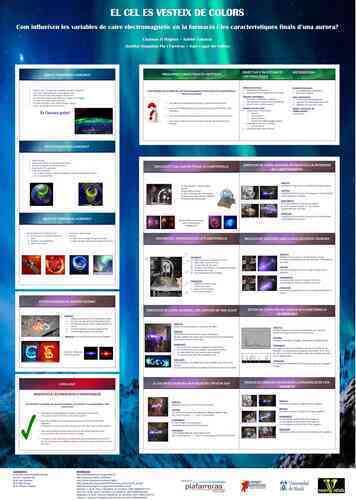El cel es vesteix de colors
sabitri valència guitart,
Chaïmae el hajjioui
INS joaquima pla i farreras – sant cugat del vallès
The polar auroras are the result of the collision between particles from the Sun, which travel along the lines of the magnetic field, with molecules of the Earth’s atmosphere. These collisions can have very significant consequences such as damaged artificial satellites, the interruption of electricity distribution networks, etc. and therefore its study is fundamental for our society.
Understanding this phenomenon has been the main objective of our research and in order to do it we have asked ourselves: How do electromagnetic variables influence the formation and the final characteristics of polar aurora?
For our research, we chose a device called Planeterrella, designed by the group of Dr. Lilensten and inspired on the Birkeland Terrella. The results of our experimentation have been:
- After simulating auroras in the interior of the Planeterrella with nitrogen gas first and with carbon dioxide gas later, it is verified that the colour of an aurora depends on the type of gas molecules with which the electrons collide.
- By varying the position of the magnetic axis of the sphere which represents the Earth, it is verified that auroras are always formed around the magnetic poles.
- By varying the intensity of the magnetic field, it is verified that the auroral oval is greater if the magnetic field is more intense.
- Modifying the voltage to simulate the solar wind activity, it is verified that the aurora shines more if the current intensity is higher, that is, if solar activity is more important
- The gases that are present in the interior of the Planeterrella can be identified by comparing the spectrum of light with an atlas of spectra.


